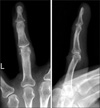Abstract
Bizarre parosteal osteochondromatous proliferation is a disease similar to an osteochondroma that usually involves the metatarsal, metacarpal, proximal and middle phalanx. The symptoms are normally caused by the bone mass, the condition has a benign clinical course but recurrence is common. Recently, it was reported that there is a translocation between chromosome 1 and 17. We report a case of BPOP in the middle phalanx of hand with translocations and duplication in cytogenetic karyotyping with a review of relevant literature.
Figures and Tables
Fig. 2
Preoperative radiographs showing a 7×7 mm sized exostotic mass on the dorsoulnar aspect middle phalanx of the 4th finger. The protruding bony mass does not connect with the medullary cavity of middle phalanx.

References
1. Breidahl WH, Wylie EJ. Bizarre parosteal osteochondromatous proliferation of the hands and feet. Australas Radiol. 1995. 39:401–404.
2. Choi JH, Gu MJ, Kim MJ, Choi WH, Shin DS, Cho KH. Fibrosarcoma in bizarre parosteal osteochondromatous proliferation. Skeletal Radiol. 2001. 30:44–47.

3. Endo M, Hasegawa T, Tashiro T, et al. Bizarre parosteal osteochondromatous proliferation with a t(1;17) translocation. Virchows Arch. 2005. 447:99–102.

4. Kim BH, Park YK, Kim YW, Yang MH. Bizarre parosteal osteochondromatous proliferation: A report of five cases. Korean J Pathol. 1996. 30:733–738.
5. Meneses MF, Unni KK, Swee RG. Bizarre parosteal osteochondromatous proliferation of bone (Nora's lesion). Am J Surg Pathol. 1993. 17:691–697.

6. Nilsson M, Domanski HA, Mertens F, Mandahl N. Molecular cytogenetic characterization of recurrent translocation breakpoints in bizarre parosteal osteochondromatous proliferation (Nora's lesion). Hum Pathol. 2004. 35:1063–1069.

7. Nora FE, Dahlin DC, Beabout JW. Bizarre parosteal osteochondromatous proliferation of hands and feet. Am J Surg Pathol. 1983. 7:245–250.
8. Spjut HJ, Dorfman HD. Florid reactive periositis of the tubular bones of the hands and feet. A benign lesion which may simulate osteosarcoma. Am J Surg Pathol. 1981. 5:423–433.




 PDF
PDF ePub
ePub Citation
Citation Print
Print








 XML Download
XML Download